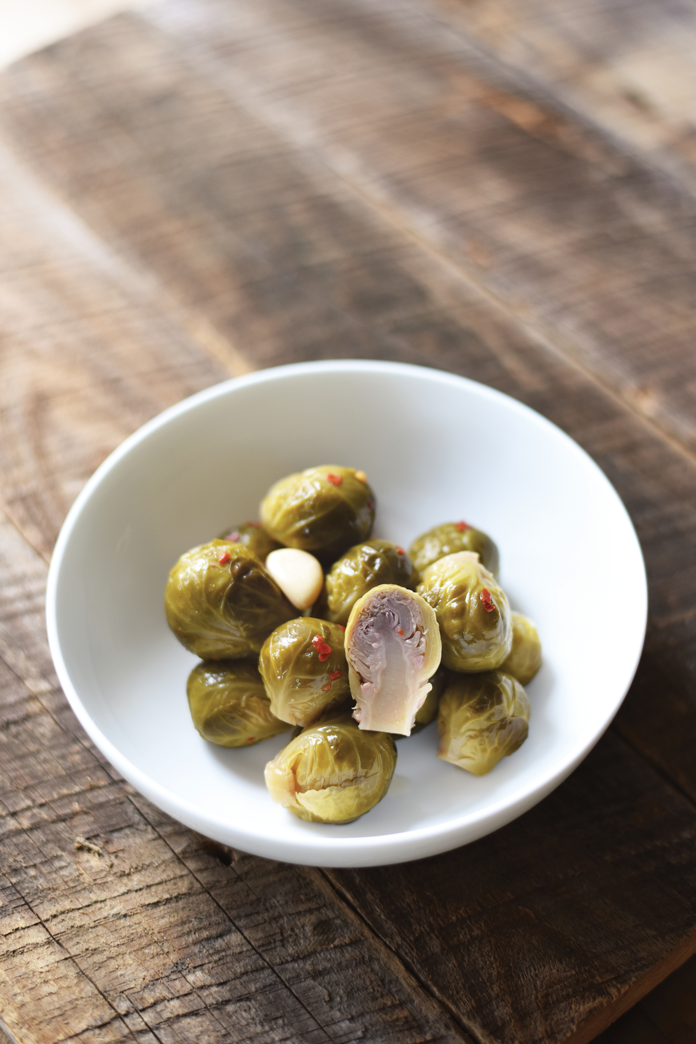
Traditionally, cucumbers have been the vegetable of choice to pickle, with varieties ranging from sour dill to hot-and-spicy. But as pickling rises in popularity, spurred by the reported heath benefits of fermentation, enthusiasts are now experimenting with new ingredients. “So many veggies and fruits too, like figs, grapes and even berries, can be pickled,” says Autumn Giles, the author of Beyond Canning. In Sweden, pickled fish is everywhere, and Giles says the recipe for pickled eggs is a favorite in her book. “I pickle them in a vinegary, Bloody Mary-inspired brine that is really delicious,” she says. “Cucumbers are definitely just the tip of the iceberg when in comes to pickling.” Here’s how you can dig into the trend with tips, local dishes and an easy recipe.
Key Points About Pickling
What you need to know about fermenting cucumbers— and beyond.

Know your Brining Basics
Fun Fact: A pickle is defined as any food that has been preserved in acid. Adding acid lowers the pH of the food so it can be stored longer. Vinegar-based brines are the most common, but fermented pickles can also be made with salt-based brines.
Savor Summer Anytime Pickling, like making jam, is a way to enjoy produce from the warmer months all year long. Fruits like peaches, cherries and grapes make for great sweet pickles, while zucchini, asparagus and green beans are good savory options.
Try New Flavor Options
As for the traditional cucumber, there are countless combinations of flavors and seasonings, like bread-and-butter, hot-and-spicy, and super-sour dill, says Jennifer MacKenzie, author of The Complete Book of Pickling. “Bread-and-butter pickles are my must-have pickle,” MacKenzie says. “I get panicky if I have to open the last jar before the next cucumber season is close.”
Reap the Health Benefits Studies have shown that pickled foods are rich in probiotics and may help address a wide range of health issues, from digestion problems to anxiety.
The Best Pickled Options In Town
Rivermarket
Tarrytown, NY
Bloody Mary

Emilio Ugarte, the bartender at Rivermarket, mixed up this flavorful take on the classic brunch cocktail. “He uses the same brine for the vegetables as we do for the pickles, which have attained a bit of a cult following with our clientele,” says owner Glenn Vogt. In the upcoming warmer weather, you can enjoy this drink on the outdoor patio, which seats 100 and has views of the Tappan Zee Bridge and Hudson River.
Balducci’s
Riverside and Westport, CT and Scarsdale, NY
Spicy Pickled Brussels Sprouts

This gourmet grocery store has a new customer favorite—their pickled Brussels sprouts, which pair perfectly with cheese and charcuterie, or alongside a main dish. “These Brussels sprouts are crisp and zesty with just the right amount of heat,” says Balducci’s Excecutive Chef Jason Miller.
Birdsall House
Peekskill, NY
Pickled Veggie Plate

Beets, watermelon, radish, carrots and many other varieties of fermented produce can be found on the pickled vegetable plate at Birdsall House, which chef Krista Espinal regularly tweaks based on what’s in season. Enjoy with a craft beer—this Westchester gastropub keeps many on tap, including local favorites, like Half Full Toasted Amber ale from Stamford, CT. birdsallhouse.net
Saltaire
Port Chester, NY
New England Lobster Salad with Pickled Pears

This salad is a decadent take on a New England classic, with brown butter hollandaise, toasted brioche bread and pickled pears. If you’re hungry for more, the house specialty is the fresh oysters, but don’t leave without trying one of their signature cocktails, like the Saltaire #3, a vodka drink infused with green chile, lime and ginger. saltaireoysterbar.com
Pickled Rhubarb Recipe
From Beyond Canning, Autumn Giles, $14
Makes: about 1 pint
Ingredients
6 ounces rhubarb sliced ½ inch thick, enough to fill a pint jar
½ cup apple cider vinegar
½ cup water
3 tablespoons sugar
Pinch of salt
Materials:
Small stainless steel saucepan
Pint jar with 2-piece closure
- Fill a pint jar to the shoulder with rhubarb slices. You can shake the jar side to side to help fit more pieces, but do not pack them too tightly.
- Bring the vinegar, water, sugar, and salt to a boil, stirring to dissolve the salt and sugar.
- Once the brine boils (it won’t take long), carefully pour the hot brine into the jar over the rhubarb slices.
- Let cool to room temperature, cover with a two-piece mason jar lid, label, and refrigerate. Wait one week before eating, if you can help it, to allow the rhubarb to cure.
Photography: Saltaire: Blythe Stoecklein; pickled onions: Neil Langan/shutterstock.com




